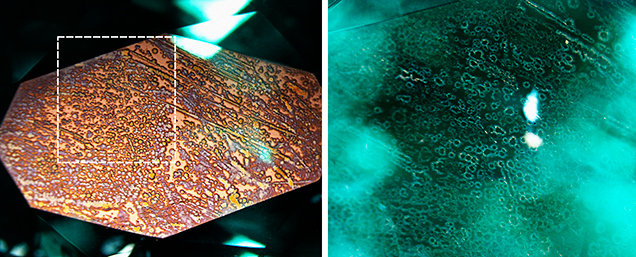Paraíba Tourmaline with Unusual Coating

Paraíba tourmaline, named after the Brazilian state where it was discovered in the late 1980s, is a precious copper-bearing tourmaline variety (e.g., J.E. Shigley et al., “An update on ‘Paraíba’ tourmaline from Brazil,” Winter 2001 G&G, pp. 260–276). Treatments such as heating and clarity enhancement have been described (e.g., S.F. McClure et al., “Gemstone enhancement and its detection in the 2000s,” Fall 2010 G&G, pp. 218–240), but coating has never been reported.
A Paraíba tourmaline ring with an unusual coating was recently submitted to GIA’s Tokyo laboratory for identification and origin service (figure 1). Standard gemological properties revealed a refractive index of 1.640–1.620, consistent with tourmaline. The stone showed medium to strong dichroism displaying greenish blue and light blue colors. Natural inclusions such as trichites and fingerprints were observed. We identified the stone as tourmaline using Raman spectroscopy. Energy-dispersive X-ray fluorescence (EDXRF) and UV-Vis spectroscopy were performed to confirm the presence of copper within the material, as well as the material’s cause of color.
Viewed face-up with the unaided eye, the stone appeared normal. However, the coated surface looked different under reflected lighting and darkfield illumination (figure 2, left). A brassy, uneven submetallic luster was observed under reflected light, while whitish features in the submetallic luster area (figure 2, right) appeared under darkfield illumination. Coatings typically show signs of wear due to their low durability. This is often seen at the facet junctions. This coating did not show signs of wear and could not be removed using a standard ink pen eraser.

Laser ablation–inductively coupled plasma–mass spectrometry (LA-ICP-MS) chemical analyses detected elements such as B, Li, and Na, indicating elbaite tourmaline. However, strong early (near-surface) peaks of elements Pt, W, and Mo, which are not normally contained in natural tourmaline, were detected. We determined that this chemistry difference probably resulted from the submetallic surface coating. As with Pt- and Pt-related coatings, it is possible that the coating was used to improve abrasion resistance (e.g., K. Schmetzer, “Surface treatment of gemstones, especially topaz – an update of recent patent literature,” Journal of Gemmology, Vol. 31, No. 1, 2008, pp. 7–13) or to assist with scanning electron microscopy (SEM) observation (e.g., I. Stokroos et al., “A comparative study of thin coatings of Au/Pd, Pt and Cr produced by magnetron supporting for FE-SEM,” Journal of Microscopy, Vol. 189, No. 1, 1998, pp. 79–89).
The reason for applying this coating is unknown. This is the first time GIA’s laboratory has observed coated Paraíba tourmaline.



